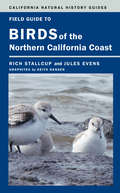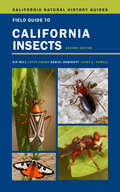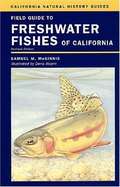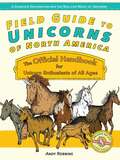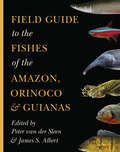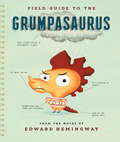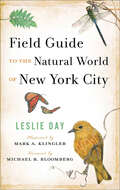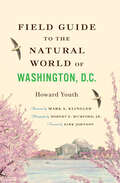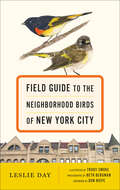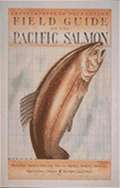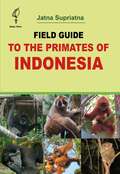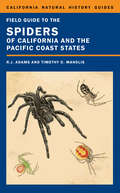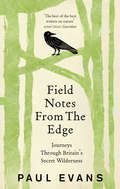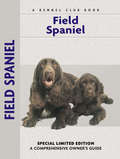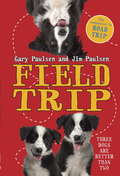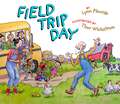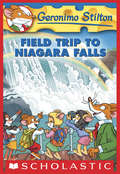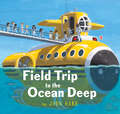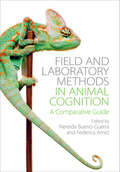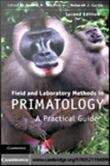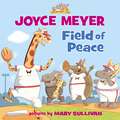- Table View
- List View
Field Guide to Birds of the Northern California Coast
by Rich Stallcup Jules EvensThe Northern California coast--from Monterey County to the Oregon border--is home to some of the richest avian habitats on the North American continent. Field Guide to Birds of the Northern California Coast provides a comprehensive ecological overview of this extensive and diverse region. It features detailed discussions of the area's most common waterbirds, raptors, and landbirds and highlights the most productive birding sites in each Northern California coastal county. Accessibly written and user-friendly, this guide contains nearly 250 species accounts that focus on seasonal rhythms and behavioral characteristics of each species. More than 130 color photographs and hand-drawn sketches depict the birds in context, and maps and occurrence charts indicate when readers might spot each species.
Field Guide to California Insects: Second Edition (California Natural History Guides #111)
by Kip WillBeautifully illustrated and approachable, this is the only California-specific, statewide book devoted to all groups of insects. Completely revised for the first time in over 40 years, Field Guide to California Insects now includes over 600 insect species, each beautifully illustrated with color photographs. Engaging accounts focus on distinguishing features, remarkable aspects of biology, and geographical distribution in the state. An accessible and compact introduction to identifying, understanding, and appreciating these often unfamiliar and fascinating creatures, this guide covers insects that readers are likely to encounter in homes and natural areas, cities and suburbs, rural lands and wilderness. It also addresses exotic and invasive species and their impact on native plants and animals. Field Guide to California Insects remains the definitive portable reference and a captivating read for beginners as well as avid naturalists.
Field Guide to Freshwater Fishes of California (Revised Edition)
by Samuel M. McginnisThis book is a field guide to all of California's 130 freshwater fish species, both native and introduced. Revised and updated throughout, the guide features the complete collection of color illustrations of California freshwater fishes available anywhere. These color illustrations, coupled with a set of highly detailed black-and-white drawings, provide a quick and easy method for identifying fish in the field.
Field Guide to North American Mammals
by National Audubon Society Staff John O. WhitakerThis guide puts the world of mammals in your hands.Each species account includes information on physical characteristics, size, similar species, breeding, tracks and other signs, habitat, and range, as well as commentary on feeding, nesting, and other behaviors.
Field Guide to Unicorns of North America: The Official Handbook for Unicorn Enthusiasts of All Ages
by Andy RobbinsBecome an expert on the various species of North American Unicornus thanks to this fun, funny, and fascinating field guide!From historical details to identification strategies, you&’ll soon be immersed in the world of unicorns that roam the wilds of North America thanks to the scientific, "fact-packed" handbook. Plus, you&’ll learn easy, step-by-step drawing techniques for when you&’re out in the wild searching for signs of unicorn presence. Along with unicorn history, popular tales, and scientific information, you&’ll be provided with in-depth details about the most popular species of North American unicorns, including: • American Unicorn • Hoary Unicorn • Spiked Bog Pony • Tropical Unicorn • And more! This field guide is perfect for any lover of these fantastic beasts, no matter if they believe unicorns to be fact or fiction!
Field Guide to the Fishes of the Amazon, Orinoco, and Guianas
by James S. Albert Peter van der SleenThe Amazon and Orinoco basins in northern South America are home to the highest concentration of freshwater fish species on earth, with more than 3,000 species allotted to 564 genera. Amazonian fishes include piranhas, electric eels, freshwater stingrays, a myriad of beautiful small-bodied tetras and catfishes, and the largest scaled freshwater fish in the world, the pirarucu. Field Guide to the Fishes of the Amazon, Orinoco, and Guianas provides descriptions and identification keys for all the known genera of fishes that inhabit Greater Amazonia, a vast and still mostly remote region of tropical rainforests, seasonally flooded savannas, and meandering lowland rivers.The guide’s contributors include more than fifty expert scientists. They summarize the current state of knowledge on the taxonomy, species richness, and ecology of these fish groups, and provide references to relevant literature for species-level identifications. This richly illustrated guide contains 700 detailed drawings, 190 color photos, and 500 distribution maps, which cover all genera. An extensive and illustrated glossary helps readers with the identification keys.The first complete overview of the fish diversity in the Amazon, Orinoco, and Guianas, this comprehensive guide is essential for anyone interested in the freshwater life inhabiting this part of the world.First complete overview of the fish diversity in the Amazon and Orinoco basinsContributors include more than fifty expertsIdentification keys and distribution maps for all genera190 stunning color photos 700 detailed line drawingsExtensive and illustrated glossary
Field Guide to the Grumpasaurus
by Edward HemingwayHave you ever met a Grumpasaurus? I bet you have. In fact, you may even have one in your own home. Want to know what makes them tick? This handy guide, meticulously researched and lovingly illustrated, tells you everything you need to know. Above all they should be handled with care—otherwise they can become VERY loud and VERY fearsome. In this appealingly modern and clever picture book, a field guide format is applied to the study of the cranky child . . . er, rather, the GRUMPASAURUS . . . who, in spite of himself, will win your heart.
Field Guide to the Natural World of New York City
by Leslie Day"This little gem fills you in on everything finned, furred, feathered, or leafed, and how to find it, in all five boroughs."—House and GardenSecond place for scholarly/reference books (design), Bookbinders' Guild of New York 2008 New York Book Show.New York just might be the most biologically diverse city in temperate America. The five boroughs sit atop one of the most naturally rich sites in North America, directly under the Atlantic migratory flyway, at the mouth of a 300-mile-long river, and on three islands—Manhattan, Staten, and Long. Leslie Day, a New York City naturalist, reveals this amazing world in her Field Guide to the Natural World of New York City. Combining the stunning paintings of Mark A. Klingler with a variety of photographs and maps, this book is a complete guide for the urban naturalist—with tips on identifying the city's flora and fauna and maps showing the nearest subway stop.Here is your personal guide to the real wild side of America’s largest city. Throw it in your backpack, hop on the subway, and explore.
Field Guide to the Natural World of Washington D.C.
by Howard YouthDiscover the wonders of Washington’s complex ecosystem with this field guide to the district’s parks, gardens, urban forests and more.Every neighborhood of Washington, D.C., is home to abundant wildlife, and its large park network is rich in natural wonders. A hike along the trails of Rock Creek Park, one of the country’s largest and oldest urban forests, quickly reveals white-tailed deer, eastern gray squirrels, and little brown bats. Mayapples, Virginia bluebells, and red mulberry trees are but a few of the treasures found growing at the National Arboretum. A stroll along the Potomac and Anacostia Rivers might reveal stealthy denizens such as bullfrogs, largemouth bass, and common snapping turtles. In Field Guide to the Natural World of Washington, D.C., naturalist Howard Youth takes readers on an urban safari, describing the wild side of the nation’s capital. Detailed drawings by Carnegie artist Mark A. Klingler and photography by Robert E. Mumford, Jr., reveal the stunning color and beauty of the flora and fauna awaiting every D.C. naturalist.Residents and tourists alike will find this guide indispensable, whether seeking a secluded jog or an adventurous outing away from the noise of the city.
Field Guide to the Natural World of Washington, D.C.
by Howard YouthA field guide to plants and animals commonly found in the nation's capital.Winner of the Design and Effectiveness Award of the Washington PublishersNature awaits discovery at almost every turn in the complex ecosystem of Washington, D.C. In parks large and small, within the District's gardens, and on public streets, there is tremendous biodiversity. In Field Guide to the Natural World of Washington, D.C., naturalist Howard Youth takes us on an urban safari, describing the wild side of the nation's capital.Beyond the abundant wildlife that can be seen in every neighborhood, Washington boasts a large park network rich in natural wonders. A hike along the trails of Rock Creek Park, one of the country’s largest and oldest urban forests, quickly reveals white-tailed deer, eastern gray squirrels, and little brown bats. Mayapples, Virginia bluebells, and red mulberry trees are but a few of the treasures found growing at the National Arboretum. A stroll along the Potomac and Anacostia Rivers might reveal stealthy denizens such as bullfrogs, largemouth bass, and common snapping turtles. Detailed drawings by Carnegie artist Mark A. Klingler and photography by Robert E. Mumford, Jr., reveal the rich color and stunning beauty of the flora and fauna awaiting every D.C. naturalist.Whether seeking a secluded jog or an adventurous outing, residents and tourists alike will find this handsome guide indispensable for finding oases away from the noise of the city.
Field Guide to the Neighborhood Birds of New York City
by Leslie Day Don RiepeNew York City's favorite naturalist is back with a guided tour of the Big Apple that unveils the beautiful birds living in its midst.Winner of the Hardcover Nonfiction (Design) of The New York Book Show, Illustrated Text of the Washington PublishersLook around New York, and you’ll probably see birds: wood ducks swimming in Queens, a stalking black-crowned night-heron in Brooklyn, great horned owls perching in the Bronx, warblers feeding in Central Park, or Staten Island’s purple martins flying to and fro. You might spot hawks and falcons nesting on skyscrapers or robins belting out songs from trees along the street. America’s largest metropolis teems with birdlife in part because it sits within the great Atlantic flyway where migratory birds travel seasonally between north and south. The Big Apple’s miles of coastline, magnificent parks, and millions of trees attract dozens of migrating species every year and are also home year-round to scores of resident birds. There is no better way to identify and learn about New York’s birds than with this comprehensive field guide from New York City naturalist Leslie Day. Her book will quickly teach you what each species looks like, where they build their nests, what they eat, the sounds of their songs, what time of year they appear in the city, the shapes and colors of their eggs, and where in the five boroughs you can find them—which is often in the neighborhood you call home. The hundreds of stunning photographs by Beth Bergman and gorgeous illustrations by Trudy Smoke will help you identify the ninety avian species commonly seen in New York. Once you enter the world of the city’s birds, life in the great metropolis will never look the same.
Field Guide to the Neighborhood Birds of New York City
by Leslie DayNew York City’s favorite naturalist returns with a guided tour of the beautiful birds living in the five boroughs.Look around New York, and you’ll probably see birds: wood ducks swimming in Queens, a stalking black-crowned night-heron in Brooklyn, great horned owls perching in the Bronx, warblers feeding in Central Park, or Staten Island’s purple martins flying to and fro. You might spot hawks and falcons nesting on skyscrapers or robins belting out songs from trees along the street.America’s largest metropolis teems with birdlife in part because it sits within the great Atlantic flyway where migratory birds travel seasonally between north and south. The Big Apple’s miles of coastline, magnificent parks, and millions of trees attract dozens of migrating species every year and are also home year-round to scores of resident birds.There is no better way to identify and learn about New York’s birds than with this comprehensive field guide from New York City naturalist Leslie Day. Her book will quickly teach you what each species looks like, where they build their nests, what they eat, the sounds of their songs, what time of year they appear in the city, the shapes and colors of their eggs, and where in the five boroughs you can find them?which is often in the neighborhood you call home. The hundreds of stunning photographs by Beth Bergman and gorgeous illustrations by Trudy Smoke will help you identify the ninety avian species commonly seen in New York. Once you enter the world of the city’s birds, life in the great metropolis will never look the same.“‘Take this guide wherever you go,’ [Day] implores readers in the introduction. And we hope many do, since it reveals a New York we long to see, the wild, beautiful city of birds known to Audubon, Chapman, and Griscom.” —Chuck Hagner, BirdWatching Magazine“An excellent guide for New York City residents. If you have any interest in the birds around you (and there are plenty of birds around you, even in NYC), this guide will really open your eyes.” —Birder's Library“Day’s deeply researched and richly illustrated Field Guide to the Neighborhood Birds of New York City will be indispensable to locals and tourists alike.” —Sierra“Will fill a niche for beginning birders and backyard watchers in the northeastern U.S.” —Choice“You don’t have to live in or be visiting New York to enjoy this book.” —Times Literary Supplement (UK)
Field Guide to the Primates of Indonesia
by Jatna SupriatnaThis primate field guide can be used to refer to information on each species, or it can be used to find which species exist on each island, as shown at the back of the book. A list of primates in Indonesia is provided with local, English, and scientific names. Once the name is identified the user can go to the description of the genus and species. Also given is the conservation status of each species except for the most recently described, whose status is not yet known. The information on each species' natural history, behavior, ecology, and where to see it in parks and/or forested areas outside parks is included. Field Guide to the Primates of Indonesia primate drawings are by Stephen Nash and photographs were donated by many of the author's friends from Indonesia and abroad.
Field Guide to the Spiders of California and the Pacific Coast States
by Richard J. AdamsWith over 40,000 described species, spiders have adapted to nearly every terrestrial environment across the globe. Over half of the world's spider families live within the three contiguous Pacific Coast states--not surprising considering the wide variety of habitats, from mountain meadows and desert dunes to redwood forests and massive urban centers. This beautifully illustrated, accessible guide covers all of the families and many of the genera found along the Pacific Coast, including introduced species and common garden spiders. The author provides readers with tools for identifying many of the region's spiders to family, and when possible, genus and species. He discusses taxonomy, distribution, and natural history as well as what is known of the habits of the spiders, the characters of families, and references to taxonomic revisions of the pertinent genera. Full-color plates for each family bring to life the incredible diversity of this ancient arachnid order.
Field Manual for Small Animal Medicine
by Katherine Polak Ann Therese KommedalField Manual for Small Animal Medicine offers anyone working in resource-limited environments a practical resource for delivering veterinary care outside the traditional hospital or clinic setting. Offers the only comprehensive resource for best practices when practicing veterinary medicine in resource-limited environments Integrates practical and cost-effective protocols where the ideal solution may not be available Presents information on vital topics such as operating a field spay/neuter clinic, emergency sheltering, sanitation and surgical asepsis, preventive care practices, zoonotic diseases, and euthanasia Serves as a quick reference guide for common surgical procedures, cytology interpretation, anesthesia and treatment protocols, and drug dosing The only comprehensive resource for practicing in resource-limited environments Integrates practical protocols for handling medical operations Coverage includes animal capture and transport, surgical operations, temporary sheltering, diagnostic techniques, medical and treatment protocols, euthanasia practices, and triage
Field Notes from the Edge
by Paul Evans‘A profoundly satisfying read’ Financial TimesIn Field Notes from the Edge, the acclaimed writer of the Guardian's 'Country Diary', Paul Evans, takes us on a journey through the in-between spaces of Nature – such as strandlines, mudflats, cliff tops and caves – where one wilderness is on the verge of becoming another and all things are possible. Here, Evans searches out wildlife and plants to reveal a Nature that is inspiring yet intimidating; miraculous yet mundane; part sacred space, part wasteland. It is here that we tread the edge between a fear of Nature’s dangers and a love of Nature’s beauty.Combining a naturalist’s eye for observation with a poet’s ear for the lyrical, Field Notes from the Edge confirms Paul Evans's place among our leading nature writers today.
Field Spaniel
by Becki Jo HirschyA close relative of the English Cocker Spaniel, the Field Spaniel is lesser known but every bit as sensible and talented as his gundog relative. A fun-loving and active sporting dog, the Field Spaniel makes an intelligent and loyal companion for owners living in a country or suburban setting. Equipped with patience and a merry good nature, this little dog is at once energetic, funny, industrious, and delightfully mischievous, a handsome addition to every home he enters. Author Becki Jo Hirschy, a well-known Field Spaniel breeder, has written a concise and accurate history of the breed in England and America, which serves as an apt introductory chapter to this Comprehensive Owner's Guide. The breed's special characteristics are discussed in the second chapter, painting an entertaining portrait of this fun-loving and sensitive breed. The complete AKC breed standard along with illustrations are presented in the third chapter.New owners will welcome the well-prepared chapter on finding a reputable breeder and selecting a healthy, sound puppy. Chapters on puppy-proofing the home and yard, purchasing the right supplies for the puppy as well as house-training, feeding, and grooming are illustrated with photographs of handsome adults and puppies. In all, there are over 135 full-color photographs in this useful and reliable volume. The author's advice on obedience training will help the reader better mold and train into the most well-mannered dog in the neighborhood. The extensive and lavishly illustrated chapter on healthcare provides up-to-date detailed information on selecting a qualified veterinarian, vaccinations, preventing and dealing with parasites, infectious diseases, and more. Sidebars throughout the text offer helpful hints, covering topics as diverse as historical dogs, breeders, or kennels, toxic plants, first aid, crate training, carsickness, fussy eaters, and parasite control. Fully indexed.
Field Trip
by Gary Paulsen Jim PaulsenFather-and-son writing team Gary and Jim Paulsen pick up where their Road Trip left off. Ben has been invited to try out for a special hockey academy. But Dad wants Ben to catch up to the school field trip instead. So Ben, Dad, and their dogs, Atticus and Conor, jump into their truck. Ben concocts a secret plan to make the tryout, but Atticus and Conor are on to him. Ben and Dad's road trip turns into a wacky adventure full of new friends and surprises.
Field Trip Day
by Lynn PlourdeToday is Field Trip Day at school, and everyone in Mrs. Shepherd?s class is excited to visit Fandangle?s Farm, especially Juan, who loves to explore. But Juan just might be too good at exploring, and Mrs. Shepherd and the chaperones have trouble keeping track of him! This sixth story about the silly students in Mrs. Shepherd?s class will have readers laughing and learning as Juan?s discoveries lead to new teaching opportunities for Farmer Fandangle and Mrs. Shepherd.
Field Trip to Niagara Falls: Field Trip To Niagara Falls (Geronimo Stilton #24)
by Geronimo StiltonEnter the world of Geronimo Stilton, where another funny adventure is always right around the corner. Each book is a fast-paced adventure with lively art and a unique format kids 7-10 will love.<P><p> Holey cheese, what an adventure! I was off to Niagara Falls with my nephew Benjamin's class. It was a beautiful place -- truly one of the most amazing sights I'd ever seen. But unfortunately, I was surrounded by mischievous young mouselets who were determined to send me over the Falls in a barrel! Oh, would I ever make it back to Mouse Island alive?<P> <i>Advisory: Bookshare has learned that this book offers only partial accessibility. We have kept it in the collection because it is useful for some of our members. To explore further access options with us, please contact us through the Book Quality link on the right sidebar. Benetech is actively working on projects to improve accessibility issues such as these. </i>
Field Trip to the Ocean Deep (Field Trip Adventures)
by John HareCome join the fun as students take a submarine bus on a field trip to explore the ocean deep, in this wordless picture book from the creator of Field Trip to the Moon!Students dressed in deep sea helmets travel to the ocean deep in a yellow school-bus submarine. When they get there, they frolic with fish, chase luminescent squid, and discover an old shipwreck. But when it's time to return to the submarine bus, one student lingers to take a photo of a treasure chest and falls into a deep ravine. Luckily, the child makes an unexpected friend-- a maybe-not-so-extinct sea creature called a Pleiosaur- that's happy to entertain the young explorer until the teacher returns. In his follow-up to Field Trip to the Moon, John Hare's rich, atmospheric art in this wordless picture book invites all children to imagine themselves in the story- a tale full of mysteries, surprises, and adorable aquatic friends. Named a LITA Golden Duck Picture BookA Junior Library Guild Selection
Field and Laboratory Methods in Animal Cognition: A Comparative Guide
by Nereida Bueno-Guerra Federica AmiciWould you ask a honeybee to point at a screen and recognise a facial expression? Or ask an elephant to climb a tree? While humans and non-human species may inhabit the same world, it's likely that our perceptual worlds differ significantly. Emphasising Uexküll's concept of 'umwelt', this volume offers practical advice on how animal cognition can be successfully tested while avoiding anthropomorphic conclusions. The chapters describe the capabilities of a range of animals - from ants, to lizards to chimpanzees - revealing how to successfully investigate animal cognition across a variety of taxa. The book features contributions from leading cognition researchers, each offering a series of examples and practical tips drawn from their own experience. Together, the authors synthesise information on current field and laboratory methods, providing researchers and graduate students with methodological advice on how to formulate research questions, design experiments and adapt studies to different taxa.
Field and Laboratory Methods in Primatology
by Joanna M. Setchell Deborah J. CurtisBuilding on the success of the first edition and bringing together contributions from a range of experts in the field, the second edition of this guide to research on wild primates covers the latest advances in the field, including new information on field experiments and measuring behaviour. It provides essential information and advice on the technical and practical aspects of both field and laboratory methods, covering topics such as ethnoprimatology; remote sensing; GPS and radio-tracking; trapping and handling; dietary ecology; and non-invasive genetics and endocrinology. This integrated approach opens up new opportunities to study the behavioural ecology of some of the most endangered primates and to collect information on previously studied populations. Chapters include methodological techniques; instructions on collecting, processing and preserving samples/data for later analysis; ethical considerations; comparative costs; and further reading, making this an invaluable tool for postgraduate students and researchers in primatology, behavioural ecology and zoology.
Field of Peace (Everyday Zoo)
by Joyce MeyerThe second book in the Everyday Zoo series, written by New York Times bestselling author Joyce Meyer, uses the beloved cast of animal characters to help readers discover the importance of finding peace in our lives by making decisions that please God. This book introduces Boyd the giraffe who is focused on his baseball team winning the championship. When faced with a teammate who isn’t performing well, Boyd must decide if he wants to win at all costs or do the right thing.
